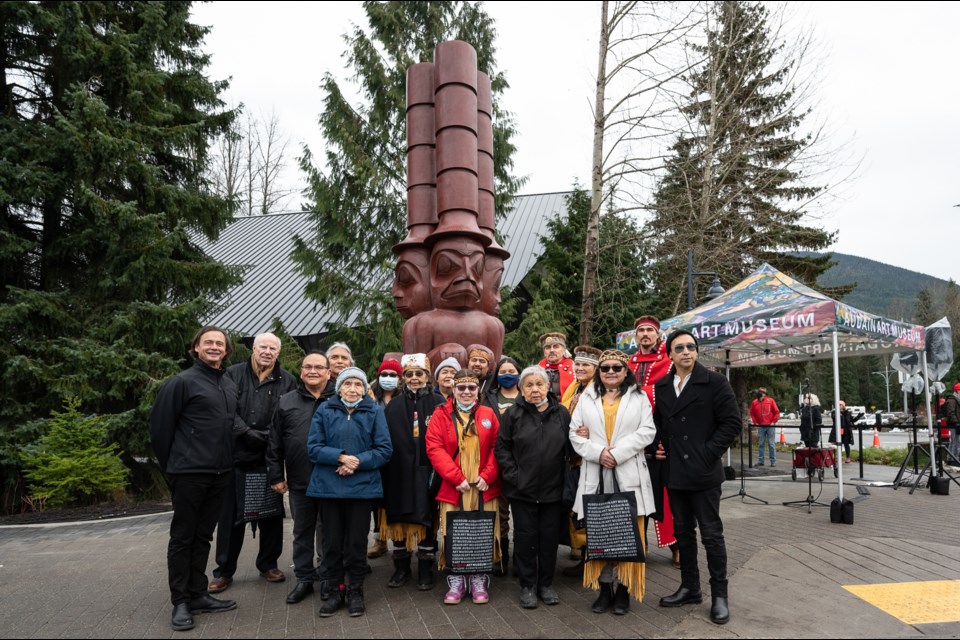The Audain Art Museum celebrated the installation of a major addition to its permanent collection this week, but the new piece isn’t located within the museum’s walls.
The six-metre-tall cast bronze statue instead stands guard over the institution’s Blackcomb Way entrance, where it will greet all locals or visitors that pass by—whether they hold an admission ticket or not.
The two-part public work, commissioned and financed by the Audain Foundation, was a ground-breaking collaborative effort between three renowned Indigenous artists from three different B.C. First nations. The massive sculpture crafted by Haida hereditary chief James (Jim) Hart (7idansuu), entitled The Three Watchmen, sits atop a concrete base encircled with a carved aluminum band entitled The Great Flood (Ti A7xa7 St’ak’), a collaboration by celebrated ߣ������(Skw̲xw̲ú7mesh) Nation artist Xwalacktun (Rick Harry) and Lil’wat (Lil’wat7úl) Nation Levi Nelson (Svpyan).
The piece was officially unveiled to the public during a ceremony on Friday, Nov. 12. “This is one of the more remarkable monumental outdoor works of art in British Columbia now, if not Canada,” says Audain Art Museum director and chief curator Curtis Collins.
“Xwalacktun and Jim are senior B.C. artists, and Levi is an up-and-coming B.C. artist, so bringing those three together, I think, makes this unique.”
The technical aspect of turning this commission into a reality also proved monumental, said Collins, offering credit to the museum’s director of operations Brianna Beacom. “We sit on a floodplain, so anchoring a major, 8,000-pound (3,630-kilogram) work of art onto a floodplain is no small feat of engineering,” he says.
For Nelson, Collins’ invitation to participate in the project was an opportunity to learn from artists he’s long looked up to.
“Rick Harry was one of my biggest influences since I was in, probably Grade 2 or 3,” Nelson recalls, over the phone from his New York City studio. The Lil’wat Nation artist is currently in his first year of a Master of Fine Art program at Columbia University.
“I had seen him on Sesame Street, and the next thing you know, he’s in my class in Grade 3, teaching us how to do Northwest Coast-style bears inside of a heart for Valentine’s Day cards.”
Working together on The Great Flood, he adds, was “a full-circle moment.”
Finished with a red ochre patina and cast at a foundry in New York, the sculpture depicts three “watchmen” looking out for danger. Similar figures often appear atop Haida totem poles. It serves as a significantly larger version of The Three Watchmen sculpture that was installed outside the National Gallery in Ottawa a decade ago.
The new water jet-carved aluminum band located on its base, meanwhile, depicts a canoe in the centre flanked by wave-like eyes, as well as the figure of a Wolf drumming in the moonlight of a starry night. The designs are inspired by Lil’wat and ߣ������Nation pictographs, said Nelson, telling important stories from each nation’s history.
According to Lil’wat lore, most animals fled the valley after the Great Flood, while the few humans who survived lived in a Long House on Lil’wat territory. As Nelson tells it, those remaining humans held a ceremony where they started dancing and, in the process, turned themselves into animals. All animals were from then on named after the respective humans they came from.
“The [drumming] wolf figure that I contributed to the piece ... is essentially half man, half wolf. And I wanted to include that because the Lil’wat Nation are descendants of the wolf clan,” Nelson explains.
The concrete and aluminum base conceived by Xwalacktun and Nelson signifies more than just celebrating the nations’ shared history and adding local context to Hart’s sculpture: because the work stands permanently on the shared, unceded territory of the Lil’wat and ߣ������First Nations, a piece from another Nation, in this case the Haida, resting directly on their land would have infringed on traditional protocol.
As Nelson explains, “Traditionally if you plant a pole ... on another person’s territory, you are essentially staking claim to it.”
Recalls Xwalacktun in a release, “Levi Nelson and I had a good feeling about working together on this project to demonstrate that The Three Watchmen is situated on our shared territory. We came up with a couple of images from Lil’wat and ߣ������territories. The Northern-style sculpture is not touching directly on our ground.”
The piece “represents a new approach to art where three artists from three different nations have come together to collaborate on a piece for public display, for reasons to follow traditional protocol, but also to stand as a symbol of where we are in art today,” says Nelson.
“If I look at The Three Watchmen, I think it’s a very historical and significant piece that points to this moment in time, where Indigenous people are starting to have a larger voice in the mainstream,” he continues. “And in a sense, I see the three watchmen as being myself, James Hart, and Xwalacktun (Rick Harry).




